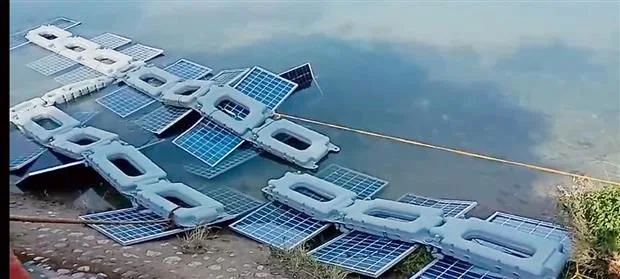
At at Bhakra Nangal site, which is the largest floating solar plant in North of India, was being installed there but has suffered damage leading to significant losses. The foundation stone for the plant, valued at Rs 90 crore, was laid by Prime Minister Narendra Modi on March 4, 2024.
The Bhakra, Himachal plant is a project of the state-owned SJVN in agreement with the Bhakra Beas Management Board (BBMB) and was expected to save close to 6,57,795 tonnes of CO2 emissions and produce over 33 million units of power output per year.
 |
| Bhakra Nangal Site |
The construction Bhakra plant was underway by a Mohali-based private company, and about 7% of the work had been completed with the aim to commission the plant in August 2024. However, a large number of solar panels installed on the reservoir were reported to have been washed away on the evening of April 27. The recovery efforts for the washed away solar panels are ongoing, and the exact reasons behind the damage and the full extent of the loss are still being ascertained.
Moving to Madhya Pradesh, it also has floating solar plant at Omkareshwar Dam, touted as the world's largest floating solar plant, suffered severe damage during a heavy storm on April 9. A video footage captured (below) the destructive impact as strong winds uprooted and damaged solar panels, disrupting operations.
Strong winds during the storm were responsible for uprooting and damaging the solar panels at Omkareshwar Dam, which disrupted the operations of the plant. Recovery efforts are underway, and officials are working to ascertain the full extent of the damage and the reasons behind it. The plant is joint venture of National Hydroelectric Power Corporation (NHPC) and Madhya Pradesh govt.
The damages to the floating solar plants at Bhakra Nangal and Omkareshwar Dam are certainly a setback, but it's important to consider it in the broader context of India's renewable energy goals. India has set ambitious targets to increase its renewable energy capacity, aiming to reach 175 GW by 2022 and 450 GW by 2030. The Bhakra Nangal solar plant was a part of this initiative, contributing to the reduction of carbon emissions and enhancing the country's power output from renewable sources.
While the damages to the two floating solar plants will affect the immediate output and delay the project, India's renewable energy goals are supported by a wide array of projects and initiatives across the country. The government and private sector are actively investing in solar, wind, hydro, and other renewable energy sources. Recovery efforts and the resilience of the renewable energy sector will play a crucial role in overcoming this incident.
Moreover, these incidents may lead to valuable lessons in engineering and site management, potentially improving the safety and durability of future projects. It's also an opportunity to reassess and strengthen disaster management strategies for such installations.
These two incidents are unlikely to significantly derail India's overall renewable energy ambitions, provided that swift action is taken to repair the damage and that the momentum in developing other renewable projects continues.
The damages to the floating solar plants at Bhakra Nangal and Omkareshwar Dam are certainly a setback, but it's important to consider it in the broader context of India's renewable energy goals. India has set ambitious targets to increase its renewable energy capacity, aiming to reach 175 GW by 2022 and 450 GW by 2030. The Bhakra Nangal solar plant was a part of this initiative, contributing to the reduction of carbon emissions and enhancing the country's power output from renewable sources.
While the damages to the two floating solar plants will affect the immediate output and delay the project, India's renewable energy goals are supported by a wide array of projects and initiatives across the country. The government and private sector are actively investing in solar, wind, hydro, and other renewable energy sources. Recovery efforts and the resilience of the renewable energy sector will play a crucial role in overcoming this incident.
Moreover, these incidents may lead to valuable lessons in engineering and site management, potentially improving the safety and durability of future projects. It's also an opportunity to reassess and strengthen disaster management strategies for such installations.
These two incidents are unlikely to significantly derail India's overall renewable energy ambitions, provided that swift action is taken to repair the damage and that the momentum in developing other renewable projects continues.








 IndianWeb2.com is an independent digital media platform for business, entrepreneurship, science, technology, startups, gadgets and climate change news & reviews.
IndianWeb2.com is an independent digital media platform for business, entrepreneurship, science, technology, startups, gadgets and climate change news & reviews.
No comments
Post a Comment